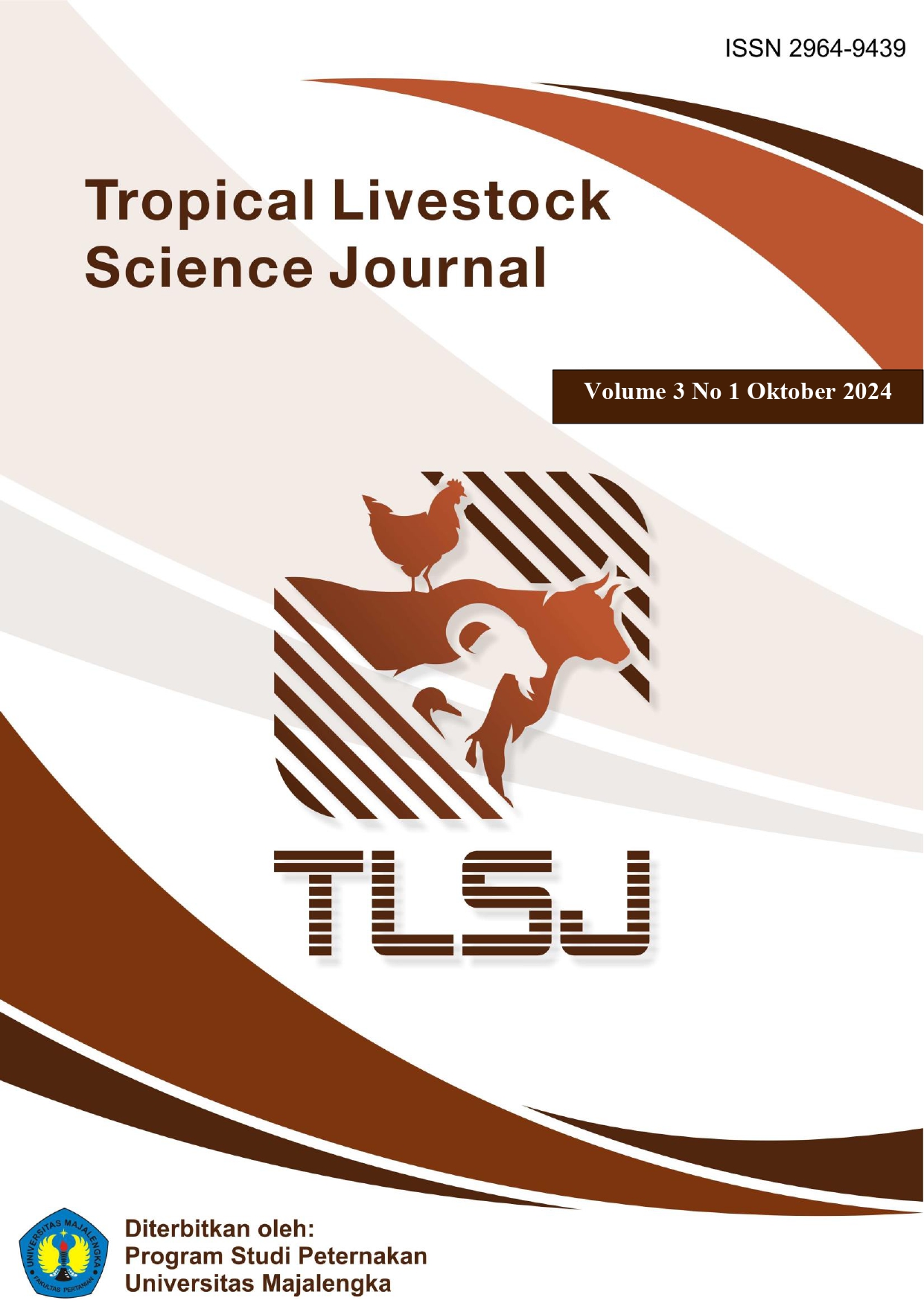Potensi Emisi Gas Rumah Kaca dari Pengolahan Limbah Peternakan Sapi Potong pada Peternakan Rakyat di Kecamatan Paseh Kabupaten Sumedang
DOI:
https://doi.org/10.31949/tlsj.v3i1.11466Abstract
The purpose of this study was to analyze the potential for reducing GHG emissions through composting beef cattle waste in the Livestock Farmers Group in Paseh District, Sumedang Regency. The method used in this study was observational and survey research. The data obtained were analyzed descriptively. The data used in this study were primary data from interviews with 53 livestock farmers in Paseh District. Direct physical observations in the field and questionnaire data. The data obtained were analyzed using the Tier-1 method in the 2006 IPCC Guidelines. The stages in calculating gas emissions include: Determining the number of populations (animal units), namely the number of populations (Animal Units) obtained from the results of multiplying the number of populations by the correction factor set for beef cattle. Calculation of Methane (CH4) Gas Emissions from beef cattle feces management was carried out using the Tier-1 method in IPCC (2006). The results of the study revealed that the main sources of emissions were enteric fermentation of 0.0669 Gg CO2-eq/year, waste processing of 0.0014 Gg CO2-eq/year, N2O emissions directly from feces processing of 290.232 Gg CO2-eq/year and indirect emissions from beef cattle feces waste processing of 0.098 Gg CO2-eq/year. The conclusion is that beef cattle waste processing in Paseh District, Sumedang Regency, contributes to reducing greenhouse gas (GHG) emissions, especially methane (CH4) and nitrous oxide (N2O).
Keywords:
Beef Cattle, Feces, Emissions, Methane, Nitrous OxideDownloads
References
Anifah, E. M., Rini, I. D. W. S., Hidayat, R., & Ridho, M. (2021). Estimasi Emisi Gas Rumah Kaca (Grk) Kegiatan Pengelolaan Sampah Di Kelurahan Karang Joang, Balikpapan. Jurnal Sains &Teknologi Lingkungan, 13(1), 17–33. https://doi.org/10.20885/jstl.vol13.iss1.art2
Choudhury, A., & Patel, K. (2010). The role of education in enhancing waste management practices. Journal of Environmental Management, 91(8), 1784-1790.
DeFries, R. S., & Karanth, K. U. (2012). Education and technology adoption in agriculture. Global Environmental Change, 22(4), 854-861.
Foley, J. A., Ramankutty, N., & Brauman, K. A. (2011). Solutions for a cultivated planet. Nature, 478(7369), 337-342.
Garnett, T., Godde, C., Muller, A., Röös, E., Smith, P., de Boer, I. J. M., Zu Ermgassen, E., Herrero, M., van Middelaar, C. E., Schader, C., & van Zanten, H. H. E. (2017). Grazed and confused? Ruminating on cattle, grazing systems, methane, nitrous oxide, the soil carbon sequestration question – and what it all means for greenhouse gas emissions. Food Climate Research Network, University of Oxford.
Giller, K. E., & Njoroge, J. (2009). Managing agricultural waste for better productivity. Soil Biology and Biochemistry, 41(11), 2231-2237.
Gillespie, J., Nehring, R., Hallahan, C., & Sandretto, C. (2016). Pasture-Based Dairy Systems: Who Are the Producers and Are Their Operations More Profitable Than Conventional Dairies Journal of Agricultural and Applied Economics, 41(3), 523-545.
IPCC (Intergovernmental Panel Climate Change). 2006. IPCC Guidelines for National Greenhouse Gas Inventories: Volume 2 -Energy, Prepared by the National Greenhouse Gas Inventories Programme, Eggleston H.S., Buendia L., Miwa K., Ngara T. And Tanabe K. (eds). Published: IGES, Japan
Mantra, I.B. 2004. Demografi Umum. Penerbit Pustaka Pelajar: Yogyakarta.
Möller, K., & Müller, T. (2018). Effects of anaerobic digestion on digestate nutrient availability and crop growth: A review. Engineering in Life Sciences, 12(3), 242-257.
Morgan, S. L., Cumbie, B. A., & Van Dyk, J. L. (2009). Practice-Oriented Research for Agricultural Development. Agricultural Economics, 40, 289-295.
Moss, A.R, Jean-Pierre. Jouany, and J. Newbold.2000. Methane Production by Ruminants: its contribution to Global Warming. Annual Zootechnology, 49(5): 231-253
Oenema, O., Wrage, N., Velthof, G. L., van Groenigen, J. W., Dolfing, J., & Kuikman, P. J. (2005). Trends in global nitrous oxide emissions from animal production systems. Nutrient Cycling in Agroecosystems, 72(1), 51-65.
Prabowo, S., Pranoto, & Budiastuti, S. (2019). Estimasi Emisi Gas Rumah Kaca yang dihasilkan dari. Bioeksperimen, 5(1), 21–23. https://doi.org/10.23917/bioeksperimen.v5i1.2795
Smith, P., Davis, S., & Misselbrook, T. (2008). Mitigation of greenhouse gas emissions from agriculture. Journal of Environmental Management, 87(1), 36-48.
Smith, P., Martino, D., Cai, Z., Gwary, D., Janzen, H., Kumar, P., McCarl, B., Ogle, S., O’Mara, F., Rice, C., Scholes, B., & Sirotenko, O. (2008). Greenhouse gas mitigation in agriculture. Philosophical Transactions of the Royal Society B: Biological Sciences, 363(1492), 789-813.
Sunusi, A., Hermami, A., Purwaningsih, Y., & Setiawan, A. (2022). Pengukuran Gas Rumah Kaca (Grk) Pada Lahan Budidaya Bawang Merah.
Zhou, Y., & Liu, L. (2013). Impact of education on technology adoption in agriculture. Agricultural Economics, 44(3), 361-373.
Published
How to Cite
Issue
Section
License
Copyright (c) 2024 Irpan Pauzan, Oki Falahudin, Aaf Falahudin

This work is licensed under a Creative Commons Attribution-ShareAlike 4.0 International License.








